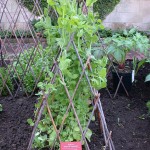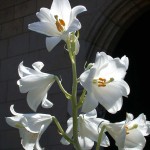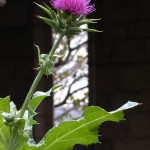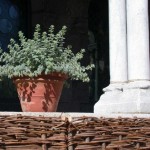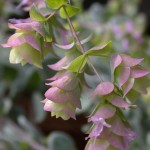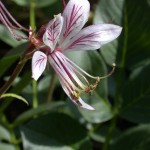Posts Tagged ‘Bonnefont Garden’
Friday, September 14, 2012
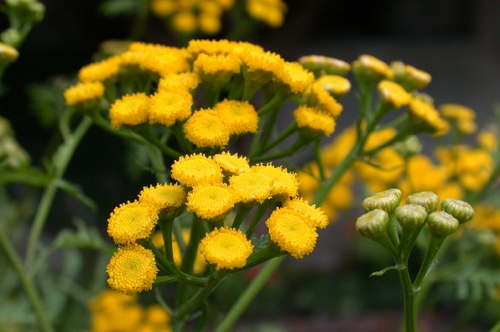
Unlike many of its relatives in the Asteraceae, or daisy family,??the golden disk flower of tansy is not surrounded by ray petals.??Although both the flowers and leaves are intensely bitter, tansy has a long history as a culinary herb.??
Tansy (reynfan) is hot and a bit moist, and is effective against all over-abundant humors which flow out. Whosoever has catarrh, and coughs because of it, should eat tansy, taken either in broth or small tarts, or with meat, or any other way. It checks the increase of the humors, and they vanish . . . .
???Hildegard of Bingen,??Physica,??Chapter CXI
The old German name reynfan used by Hildegard refers to the effect of tansy (Tanacetum vulgare) on the “reins,” or kidneys. The fifteenth-century herbal??Der Gart der Gesundheit differs from Hildegard in classifying tansy as hot and dry in the first degree, rather than moist; it recommends tansy as a diuretic and vermifuge, as well as a treatment for gout and fever. (For more on Hildegard of Bingen, see “Mutter Natur,” October 15, 2010. For more on the humoral theory on which her prescription is based, see “Cool, Cooler, Coolest,” July 27, 2012.) Read more »
Tags: Bonnefont Garden, daisy, Hildegard of Bingen, John Gerard, reynfan, Tanacetum, tansy, Walahfrid Strabo
Posted in Food and Beverage Plants, Gardening at The Cloisters, Medicinal Plants, The Medieval Garden | Comments (0)
Friday, June 15, 2012
The Cloisters offered its annual Garden Days program on June 2 and 3. We had splendid weather and a great turnout. Deirdre Larkin, familiar to all of our regular readers, led garden tours in which she explored the theme of wild and cultivated plants in the Middle Ages. Instructors from our Education Office led workshops for children and their families.

Deirdre Larkin, at center, discussed wild and cultivated plants in the Bonnefont herb garden. Some of the plants in the garden are considered weeds today but were highly valued in the medieval world. Most of the beds in Bonnefont are planted according to use; nearly every bed was completely replanted this spring. Photograph by Nancy Wu
Read more »
Tags: Bonnefont Garden, Cuxa Garden, Garden Day, weed
Posted in Gardening at The Cloisters | Comments (2)
Thursday, July 21, 2011
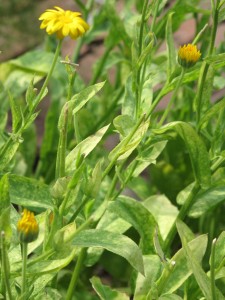
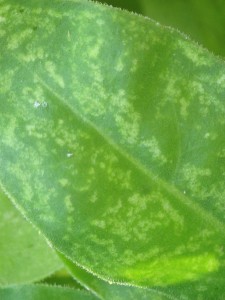
Left: A severe infestation of two-spotted mites on a calendula growing in Bonnefont garden. Right: A detail of the damage done by this common hot-weather garden pest, which sucks the chlorophyll from the leaves of the host plant. Photographs by Corey Eilhardt
The hot, dry weather that has us struggling to keep the gardens watered is all too welcome to the two-spotted mite, Tetranychus urticae, a worldwide pest of crop plants, ornamentals, and houseplants that is as much at home in greenhouses and apartments as it is outdoors. Two-spotted mites, along with other members of the Tetranychus family, are commonly known as spider mites. They are arachnids but are more closely related to ticks than to spiders.
Read more »
Tags: Bonnefont Garden, Calendula officinalis, catmint, hops, humulus lupulus, lady???s mantle, Levisticum officinale, lovage, meadow rue, Nepeta x faassenii, pest, Phytoseiulus persimilis, pot marigold, spider mites, Tetranychus urticae, Thalictrum aquilegifolium, two-spotted mite
Posted in Botany for Gardeners, Gardening at The Cloisters | Comments (2)
Friday, October 15, 2010
Many of the healing herbs, flowers, and foodstuffs mentioned by the twelfth-century Benedictine abbess Hildegard of Bingen in her great work Physica are grown in Bonnefont garden at The Cloisters. Above, from left to right: Field peas (Pisum sativum arvense,??variety ‘Blue Pod Capucijners’); Madonna lily (Lilium candidum); milk thistle (Silybum marianum).?? Photographs from the Gardens archives.
It is the first book in which a woman discusses plants and trees in relation to their physical properties. It is the earliest book on natural history to be done in Germany and is, in essence, the foundation of botanical study there. It influenced the 16th-century works of Brunfels, Fuchs, and Bock, the so-called ???German fathers of botany,??? but the fact is that German botany is more indebted to a ???mother.???
???Frank Anderson on the Physica, from An Illustrated History of the Herbals
Certain plants grow from air. These plants are gentle on the digestion and possess a happy nature, producing happiness in anyone who eats them. They are like a person???s hair in that they are always light and airy. Certain other herbs are windy, since they grow from the wind. These herbs are dry, and heavy on one???s digestion. They are of a sad nature, making the person who eats them sad. They are comparable to human perspiration. Moreover, there are herbs which are fatal as human food . . . they are comparable to human excrement.
???From Book I of the Physica, translated by Priscilla Throop
Hildegard of Bingen, Benedictine abbess, visionary, poet, dramatist, composer, and the most learned woman of the twelfth century, wrote the Physica, or Natural Science, about the year 1150. Read more »
Tags: Bonnefont Garden, field peas, Hildegard von Bingen, lily, medicinal plant, milk thistle, Silybum marianum
Posted in Botany for Gardeners, Gardening at The Cloisters, Medicinal Plants, Plants in Medieval Art | Comments (4)
Friday, August 6, 2010
Above: The left and center image show the true or “right dittany” of Crete (Origanum dictamnus), a tender Mediterranean species grown in pots in Bonnefont garden. This pretty relative of the culinary oreganos is endemic to the island, and is found growing wild only in the mountains there. The small, purplish-pink flowers are borne on long-lasting bracts in late summer and fall. The image on the right shows Dictamnus albus, known as white dittany or fraxinella, which is a botanically unrelated species. Medieval herbalists seem to have transferred both the name and the??marvelous properties that the ancients ascribed to true dittany to this herb.
Origanum dictamnus, with its round, woolly gray leaves,??rosy??bracts and delicate purplish-pink flowers, is the prettiest of the tender medieval species grown in pots in Bonnefont garden, and the most difficult for us to grow. One of a number of species endemic to the mountains of Crete, the wild plant is only found growing in the crevices of limestone gorges and ravines (see image). Known as diktamnon in Greek, it is said to be named after Mount Dikti. Read more »
Tags: Aeneas, antidote, Aristotle, artemidon, Artemis, Bonnefont Garden, Cos, Crete, diktamnon, Dioscorides, Hellmut Baumann, Hippocrates, Mount Ida, Origanum dictamnus, snake, snakebite, Theophrastus, venom, Venus, Virgil, William Turner
Posted in Fragrant Plants, Gardening at The Cloisters, Medicinal Plants | Comments (1)
Friday, July 18, 2008


The most imposing of the several thistles we cultivate at The Cloisters, the stately cotton thistle has a presence that appeals to modern sensibilities. The silvery-white leaves are deeply cut and very handsome: the species name acanthium denotes their resemblance to the foliage of the acanthus. Some value cotton thistle as an ornamental in contemporary gardens, although others consider Onorpordum acanthium to be a weed. (A weed is a plant you don’t want, while an herb is a plant with a use. Many of the plants we grow in the gardens of The Cloisters are considered weeds in our time and place, but were herbs in the Middle Ages.) Once the purplish-pink flowers of the cotton thistle have withered, it is important to remove the heads so that the many seeds do not disperse to the four winds and colonize the world. Read more »
Tags: Bonnefont Garden, Onopordum acanthium, thistle
Posted in Botany for Gardeners, Gardening at The Cloisters, Useful Plants | Comments (2)
Tuesday, July 8, 2008
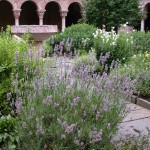
Above: Lavandin (Lavandula x intermedia) flowering in Cuxa Garden.
Lavenders in The Middle Ages
Lavender (Lavandula angustifolia ssp. angustifolia) was used to scent linen and to keep moths and insects from woolens, as it still is. According to the fifteenth-century herbal Hortus Sanitatis, or the Garden of Health, this virtue of protecting clothing from vermin endeared lavender to the Mother of God, who also loved the herb as a preserver of chastity: “If the head is sprinkled with lavender water it will make that person chaste so long as he bears it upon him.” (Margaret Freeman, Herbs for the Medieval Household, 1943.)
Lavender had a number of medicinal applications as well as household uses, and could be employed against pains in the heart, fainting spells, and sleeplessness; it was applied to the forehead for headache and included in antidotes, such as a plaster for scorpion bites. It was used internally as well as externally, and a decoction was drunk for epilepsy and kidney ailments and as a preventative for apoplexy. (Frank Anderson, German Book Illustration through 1500: Herbals through 1500, 1983???4.) Read more »
Tags: Add new tag, Bonnefont Garden, Cuxa Garden, lavandin, Lavandula, lavenders
Posted in Fragrant Plants, Gardening at The Cloisters, Medicinal Plants | Comments (4)
Tuesday, July 1, 2008
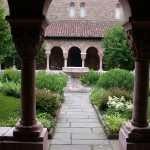
Welcome to The Medieval Garden Enclosed, a blog dedicated to the plants and gardens of The Cloisters, a branch of The Metropolitan Museum of Art. Enter and explore the role of plants and gardens in medieval life and art, learn how to find and grow medieval herbs and flowers, discuss the long histories of many familiar garden plants, discover which roadside weeds were once valued medicinals, and encounter legendary plants like the mandrake (Mandragora officinarum.) Read more »
Tags: Bonnefont Garden, Cuxa Garden, garth, hortus conclusus, Trie Garden
Posted in Introduction | Comments (54)





